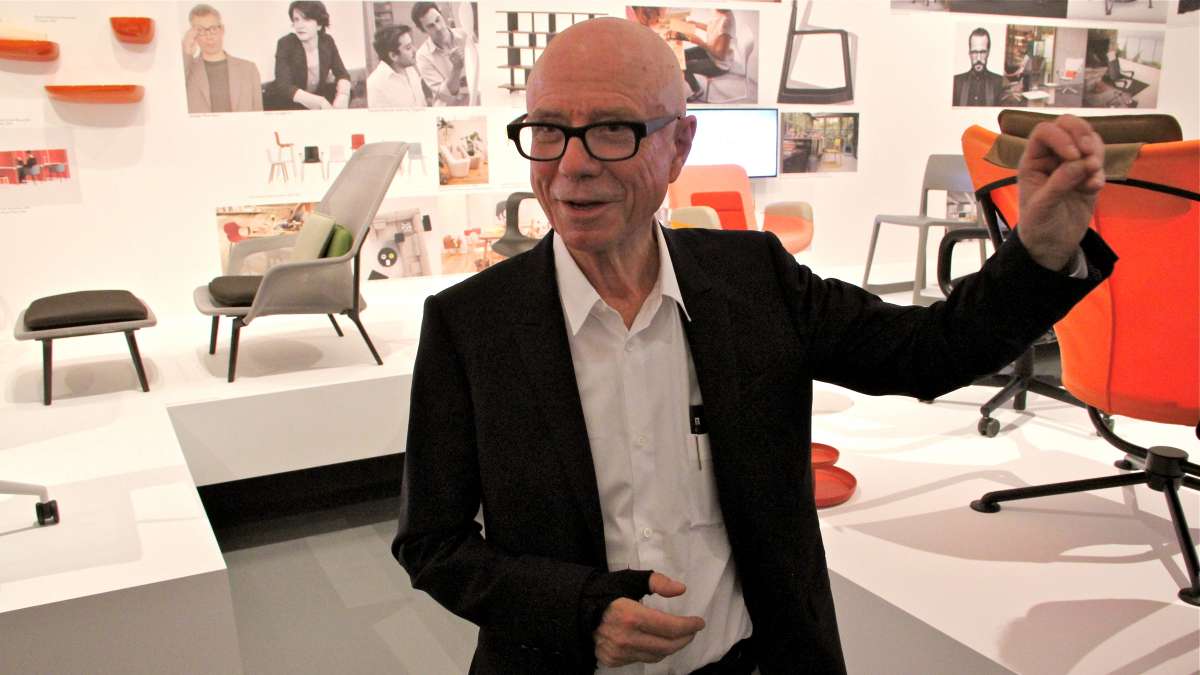Seats of honor celebrated at Philadelphia Museum of Art [photos]
Sometimes a chair is not just a chair.
It’s a throne. It’s a cradle. It’s a basket. It’s a cardboard box. It reclines. It collapses. It commands. It rolls. It’s a plank. It’s a net. A sling. A bush.
“It’s also very close to the human, insofar as it has arms, legs, and a back,” said Rolf Fehlbaum, chairman emeritus of Vitra, a Swiss design firm started by his parents.
“Think of it as an alter ego of man,” he said. “It positions the person. It is an issue of status, taste, attitude, lifestyle, so over time invents its own expressions.”
Fehlbaum has worked with some of the greatest architects and designers of the 20th century – Frank Gehry, Zaha Hadid, George Nelson, Charles and Ray Eames – all of whom created new ideas for arguable the oldest man-made object in the world: a place to sit.
He is in Philadelphia to launch the exhibition “Vitra — Design, Architecture, Communication: A European Project with American Roots” at the Philadelphia Museum of Art.
Vitra was born in 1957 when Fehlbaum’s parents, Willi and Erika, won the license to manufacture the Herman Miller Collection in Europe. They bought the right to manufacture and sell pieces including the Nelson sunburst clock and the legendary Eames chair, by some of the greatest designers in America.
Eventually the company started to champion and commission its own roster of designers.
“To be active in design, that was my role,” said Fehlbaum, who took over the company in 1977. “That’s the only thing I was not terrible at. I was not so good at the other stuff.”
He stepped into that role in a major way after a fire destroyed much of Vitra’s manufacturing plant in Weil am Rein, Germany, in 1981. To replace that building, he asked rising talent Gehry — pre-Bilbao, pre-“starchitect” – to design what would become his first construction in Europe.
Since then, the Vitra campus has turned into a showcase of contemporary architecture, including buildings by Herzog and de Meuron, Alvaro Siza, and Hadid. Hadid’s Firehouse at Vitra is her first constructed design.
The exhibition at PMA is, naturally, heavy with chairs (none of which may be used) including Gehry’s cardboard chair and ottoman, experiments by the Eameses, and selections of contemporary office furniture.
Some pieces seem so common – the wire-mesh furniture and molded-plastic chairs, for example – it’s hard to realize it took years of invention and experimentation to arrive at their simplicity. By contrast, some pieces are so complicated and sophisticated that they are impossible to produce for the marketplace. They exist more as art objects.
“We don’t create for the collector,” said Fehlbaum. “We are interested in these objects that are sometimes desired by collectors, as an experimental way of learning more, trying new relationships, new materials. But it is not a business. It’s research.”
While in Philadelphia to set up the exhibition and receive the annual Design Excellence Award from Collab, the museum’s contemporary design group, Fehlbaum took time to visit some of the region’s design landmarks, including The Wharton Esherick Studio museum in Malvern and Robert Venturi’s Mother’s House in Chestnut Hill.
He also took a look at some chair prototypes coming out of local design schools. Students were invited to submit their designs into competition. Jude Marks of the University of the Arts won with his chair canopied by a trellis through which a living plant grows. The sitter would be enveloped by vine.
Fehlbaum literally applauded another chair, by grad student Clementine Gilbert at the University of Pennsylvania, that responded to the sound of his hand clap. The chair was wrapped in electroluminescent wire that pulsates to sound in the environment.
Fehlbaum was more interested in chairs that responded to contemporary ideas – interactivity and environmental concerns – than designs fit for production.
“With a student, I think it’s interesting to catch a contemporary theme, which hasn’t been dealt with in the same way,” said Fehlbaum. “Rather than doing a chair that has been done 100 times with a new variation, to do something with a theme that was not a theme in the mainstream — that is interesting.”
WHYY is your source for fact-based, in-depth journalism and information. As a nonprofit organization, we rely on financial support from readers like you. Please give today.













